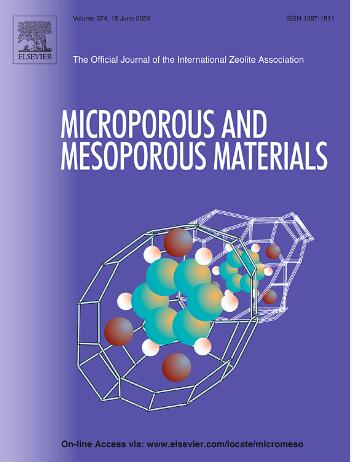Synthesis of MIL-101 embedded in SBA-16 functionalized with carboxyl groups as a catalyst for Knoevenagel reaction
IF 4.8
3区 材料科学
Q1 CHEMISTRY, APPLIED
引用次数: 0
Abstract
In this paper, carboxyl-functionalized silica (SBA-16-xC) was prepared by one-pot method using 2-cyanoethyltriethoxysilane (CTES) as a carboxylate precursor reagent and then MIL-101 functionalized composites (SBA-16-xC@MIL-101) were synthesized in situ by using carboxyl groups (-COOH) of the functionalized silica to adsorb chromium ions. The physicochemical properties of composites were characterized by Nitrogen adsorption/desorption, FT-IR, XPS, XRD, TG, SEM, TEM, and 13C NMR. That the cyano groups (-CN) were completely converted to carboxyl groups and MIL-101 was successfully prepared in the pores and surface of SBA-16-xC. SBA-16-1C@MIL-101 was employed as a catalyst for the Knoevenagel reaction was carried out using benzaldehyde and malononitrile as raw materials and water as a solvent. The reaction rate gradually increased with increasing reaction temperature. At a reaction temperature of 50 °C, the conversion of benzaldehyde reached 100 % after 50 min with an average reaction rate of 9.03 × 10−3 mol/(L·min). In recycling experiments, SBA-16-1C@MIL-101 did not show any significant change in catalytic performance after five cycles.

求助全文
约1分钟内获得全文
求助全文
来源期刊

Microporous and Mesoporous Materials
化学-材料科学:综合
CiteScore
10.70
自引率
5.80%
发文量
649
审稿时长
26 days
期刊介绍:
Microporous and Mesoporous Materials covers novel and significant aspects of porous solids classified as either microporous (pore size up to 2 nm) or mesoporous (pore size 2 to 50 nm). The porosity should have a specific impact on the material properties or application. Typical examples are zeolites and zeolite-like materials, pillared materials, clathrasils and clathrates, carbon molecular sieves, ordered mesoporous materials, organic/inorganic porous hybrid materials, or porous metal oxides. Both natural and synthetic porous materials are within the scope of the journal.
Topics which are particularly of interest include:
All aspects of natural microporous and mesoporous solids
The synthesis of crystalline or amorphous porous materials
The physico-chemical characterization of microporous and mesoporous solids, especially spectroscopic and microscopic
The modification of microporous and mesoporous solids, for example by ion exchange or solid-state reactions
All topics related to diffusion of mobile species in the pores of microporous and mesoporous materials
Adsorption (and other separation techniques) using microporous or mesoporous adsorbents
Catalysis by microporous and mesoporous materials
Host/guest interactions
Theoretical chemistry and modelling of host/guest interactions
All topics related to the application of microporous and mesoporous materials in industrial catalysis, separation technology, environmental protection, electrochemistry, membranes, sensors, optical devices, etc.
 求助内容:
求助内容: 应助结果提醒方式:
应助结果提醒方式:


